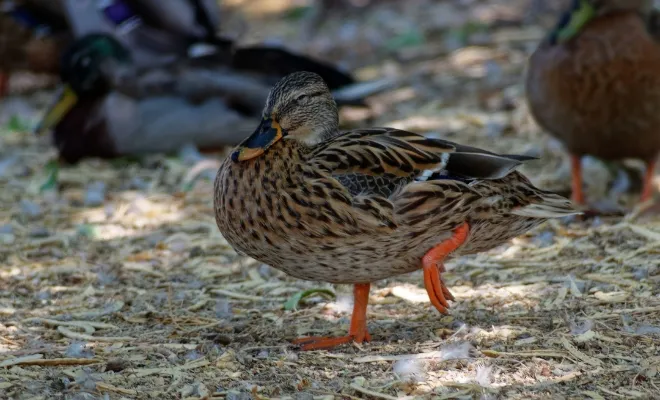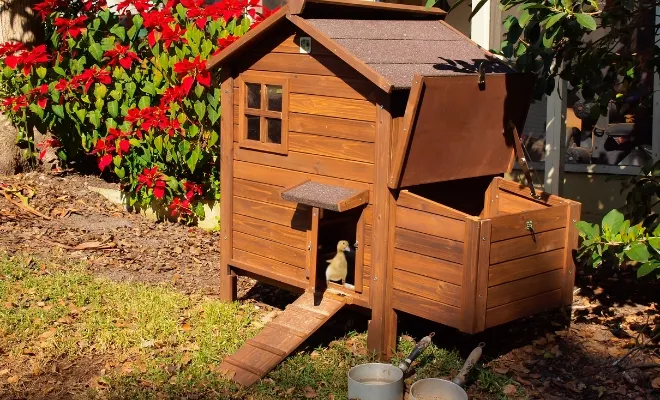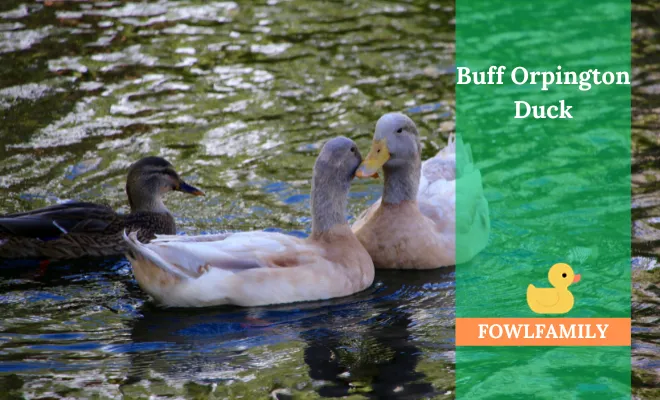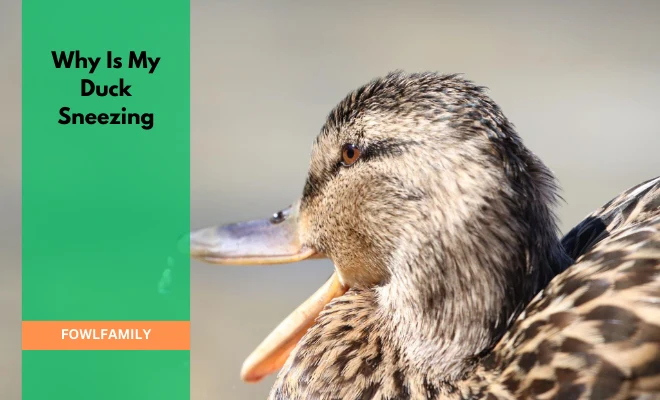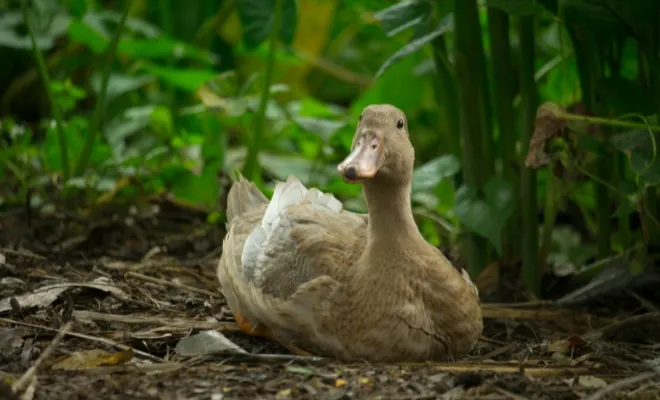10 Best Duck Breeds For Pets: Find Your Ideal Company
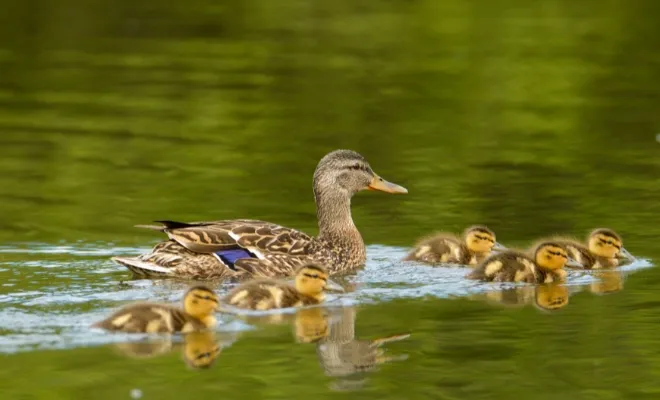
What are the best duck breeds for pets? Well, it’s pretty tricky to answer. Actually, any duck breed can be raised as a pet. You just have to be mindful of which breed is compatible with you.
Still, my list of ducks is prolific egg layers, beautiful, and have something that keeps them apart from the other breeds. In that consideration, Pekin, Welsh harlequin, Cayuga, Indian Runners, and khaki Campbell might be the best choice.
However, there are other duck breeds that will make fantastic company for humans as well. Keep on reading to know a bunch of ducks that will be amazing pets for you.
Table of Contents
10 Best Duck Breeds For Pets: An All in All Analysis
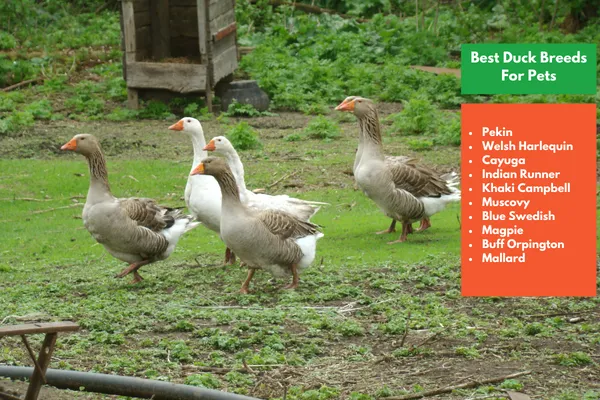
There are more than 130 duck species in the world. Almost all ducks are beautiful and have their distinctive natures. But picking the best ducks for pets depends on many factors.
Considering the facts, I have picked the 10 best duck breeds for pets here. Before going deeper, here is the list of 10 duck breeds I have picked for pets.
- Pekin
- Welsh Harlequin
- Cayuga
- Indian Runner
- Khaki Campbell
- Muscovy
- Blue Swedish
- Magpie
- Buff Orpington
- Mallard
Let’s get to know why they’re the best.
1. Pekin Duck
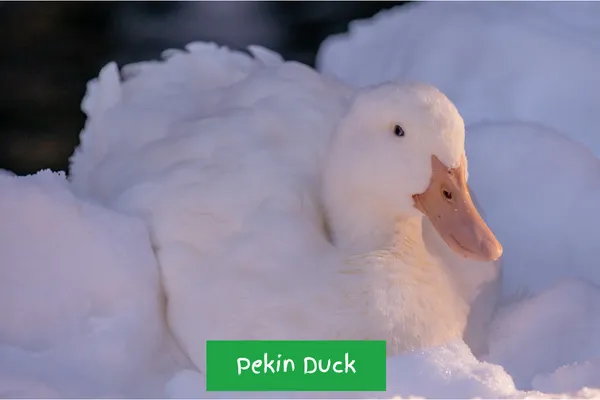
Pekin ducks are my first choice when I talk about pet ducks. They’re adorable, friendly, and a popular duck breed in North America. Let’s see how well-matched they are as pets.
| Characteristics | Description |
|---|---|
| Appearance | Pristine-white, neat, and easily recognizable |
| Weight | 12 pounds |
| Nature | Friendly |
| Form strong bonds with owners and be playful. | |
| It can be loud. | |
| Adaptability | Highly adaptable |
| Serving Purposes | Known for egg-laying (around 300 eggs per year) |
| Lifespan | 8 – 12 years |
| Disease Resistance | Prone to health sickness (such as Anatipestifer infection) due to their size, leading to shorter lifespans. |
| Unique Feature | American Pekins are large and suitable for meat production but require more space to live. |
In a nutshell, Pekin ducks are just too good to deal with. They’re friendly, adaptable, can lay eggs, and have adorable personalities. But the short lifespan may force you to think twice. Plus, they’re prone to illnesses such as obesity.
Related Articles:
2. Welsh Harlequin
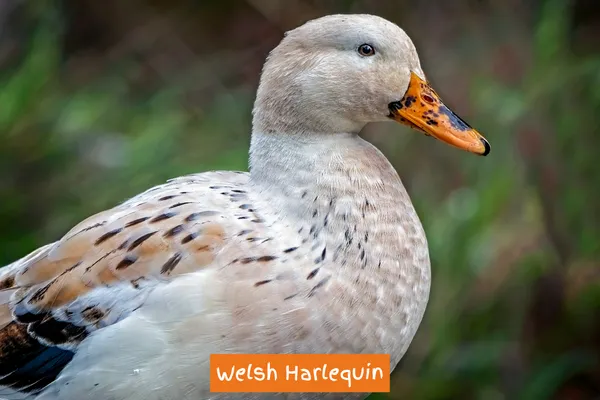
The Welsh Harlequin duck originated from Wales, UK. Some duck owners claim Welsh Harlequin is the coolest pet duck they’ve ever seen.
The attractive look, fascinating history, and calm and composed behavior are what influenced me to pick it as one of the top three best pet ducks. Let’s check how else they’re better as pets.
| Characteristics | Description |
|---|---|
| Appearance | Male: Striking green iridescent heads and pale creamy bodies |
| Female: Mottled light brown and creamy white bodies. | |
| Serving Purpose | Excellent egg-layers, potentially producing up to 330 eggs per year. Suitable for consistent egg supply. |
| Size and Weight: | The average size ranges from 4.5 to 5.5 pounds. Not too big, not too small. |
| Lifespan | Up to 20 years |
| Flight Capability | Weak flying capacity, unlikely to fly away from home. |
| Adaptability | Hardy is a self-sufficient forager |
| Good at finding their own food. Exceptional mothers. | |
| Vocal Nature | Not known for excessive quacking but likes to make some noise, typical of ducks. |
| Unique Identification | Male harlequins often have darker heads, allowing for gender differentiation at birth. |
Welsh Harlequin are fascinating duck breeds. They’re prolific egg layers, good moms, and do not fly, making it a perfect choice as a backyard duck. They’re neither noisy nor quiet. So, be mindful of that before taking it into your house. Suitability first!
Watch this video to know what a Welsh Harlequin owner says about this beautiful bird:
3. Cayuga Duck
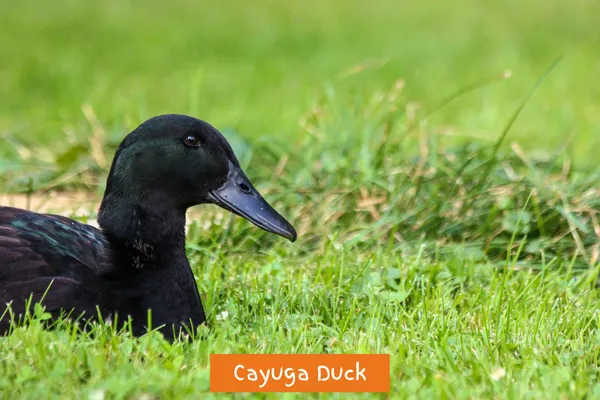
Cayuga is an authentic American duck breed. These ducks originated from New York City in the middle of the 19th century. Cayugas are like sweethearts to me. Their nice appearance, moderate egg-laying capability, and quiet nature keep them apart from other breeds. Let’s get into their characteristics a little more.
| Characteristic | Description |
|---|---|
| Appearance | Iridescent green-black feathers |
| Nature | Generally quiet, some can be loud, maybe shy |
| Weight | 7-8 pounds |
| Adaptability | Thrive in various environments, good swimmers and foragers live up to a decade |
| Lifespan | 8 – 12 years |
| Serving Purposes | Egg production: 100-150 eggs annually, and also suitable for meat production. |
| Disease Resistance | A fair level of disease resistance, hardy |
| Unique Features | Iridescent green-black feathering |
However, the level of adaptability is already mentioned. Just think how hardy this mighty breed is – they produce offspring in extreme cold weather in Northern America. It’s an all-in-one package!
4. Indian Runner Duck
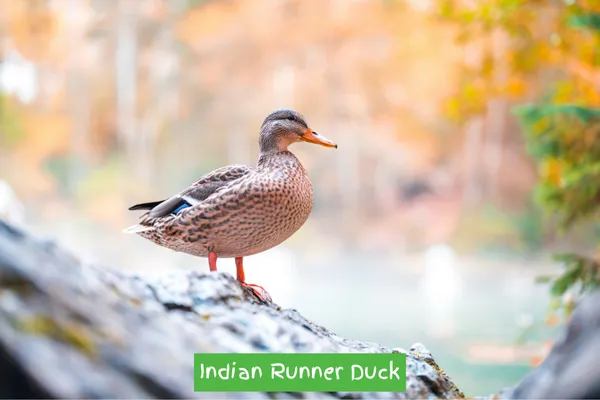
Mighty egg layers! That’s enough to introduce Indian Runner ducks. One of the best egg layers breeds as well as a very suitable choice for hand raising. Plus, their penguin-like appearance is just too adorable. Let’s know why they’re so good as pets.
| Characteristic | Description |
|---|---|
| Appearance | Tall, straight posture |
| Penguin-like legs | |
| Various colors (e.g., chocolate, black, white) | |
| Nature | Efficient foragers |
| Weight | 4.4 – 5 Pounds |
| Adaptability | Tolerant of diverse environments |
| Lifespan | 8 – 12 years |
| Serving Purposes | Exceptional egg layers (approx. 300 eggs per year) |
| Assist with pest control in garden and farming setup. | |
| Disease Resistance | Resilient to illnesses, reducing concerns for raisers |
| Unique Feature | Notable for running, not waddling or flying Unique leg structure sets them apart. |
In a nutshell, Indian runners are pretty easygoing and are friendly toward humans. Won’t you pick ducks with such qualities?
5. Khaki Campbell
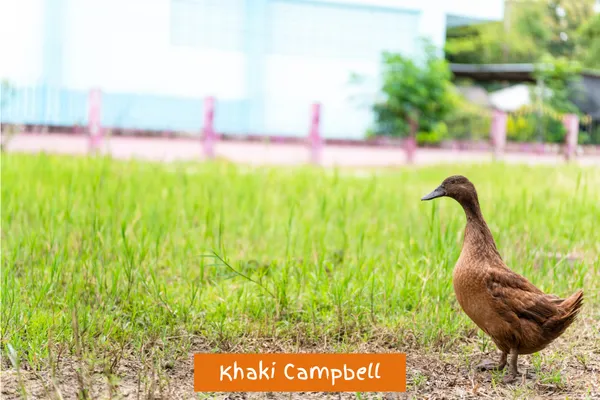
Khaki Campbells originated as a British duck breed in England. It was introduced as the Khaki ducks in the early 20th century. So, it’s not an old duck breed compared to Welsh Harlequin, Indian Runners, or Blue Swedish ducks. Let’s have a look at their characteristics in a nutshell.
| Characteristics | Description |
|---|---|
| Appearance | Male: Dark brown heads, necks, backs, and tails. |
| Female: Light brown all over. | |
| Weight | 4 – 4.5 pounds |
| Nature | Generally friendly but easily startled, not very cuddly |
| Adaptability | Highly adaptable, best in calm, low-stress environments |
| Lifespan | 10 – 15 years |
| Serving Purposes | Excellent egg layers (340 eggs per year) |
| Disease Resistance | Average resistance requires proper care and management |
| Unique Features | Quiet demeanor, cannot fly, exceptional egg-laying ability, not good at raising ducklings. |
See, Khaki Campbells are elite-class ducks. Why am I calling it? Because they are cooperative, nice to see, and have nice personalities. While buying Khaki Campbells, buy a couple of ducks because they require their own company.
6. Muscovy Duck

Muscovy ducks are famous for their big size. They’re not great egg layers, but their appearance and cost efficiency help them top the chart of pet ducks. Let’s get to know their characteristics a little more.
| Characteristics | Description |
|---|---|
| Appearance | Male: Glossy iridescent black plumage. |
| Female: Smaller, black plumage, may have some white, no bare skin on the face. | |
| Weight | 6 – 15 pounds |
| Nature | Has a wild streak and can be a bit skittish. They prefer perching up high and need time to get used to people. |
| Adaptability | Less ‘domesticated’ and better suited for experienced duck raisers. |
| Lifespan | Up to 20 Years |
| Serving Purposes | Meat Production. |
| They are not the best egg layers but can produce around 3 to 4 eggs per week with creamy-colored shells. | |
| Disease Resistance | They are known for their hardiness and resistance to diseases, making them low-maintenance ducks. |
| Unique Features | They are a natural breed with no genetic links to the common Mallard, giving them unique behavior and wild charm. |
Muscovy isn’t really a pet kind of duck. Still, why are they on the list? It’s because they have not been messed with through selective breeding like many other Domestic ducks. So, their behavior has a unique height, which may attract experienced duck raisers.
7. Blue Swedish Duck
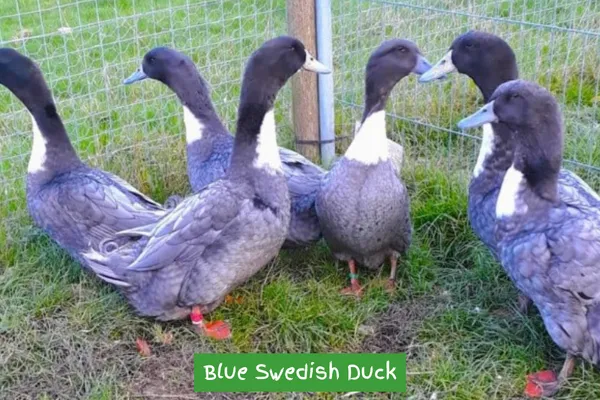
Blue Swedish is a heritage duck. It’s even older than the Indian Runner and Pekin ducks! This duck breed originated from the Kingdom of Sweden back in 1835, and 50 years after that, it was imported to America.
It serves various purposes and is surely one of the best breeds to make pets. Here’s more on that:
| Characteristics | Description |
|---|---|
| Appearance | Stunning blue feathers with white bib |
| It can be black or silver | |
| Weight | 7 to 9 pounds |
| Nature | Calm and friendly |
| Suitable for both experienced and new owners | |
| Moderate noise level | |
| Adaptability | Handle different environments well |
| Tough and cold-resistant | |
| Good at finding their own food | |
| Serving Purposes | Not heavy egg layers (100-150 eggs/year) |
| Kept as pets and shown at exhibitions | |
| Disease Resistance | Resistant to illnesses such as avian influenza. |
| Lifespan | 8 – 12 years |
| Unique Features | Beautiful blue feathers |
| Endangered breed |
See, Blue Swedish ducks aren’t great egg layers, But what do you want whenever you pet an animal to fulfill your hobby? You want it to be beautiful and adorable, and you’ll feel pretty happy when seeing others praising your birds for their distinctive appearance.
Swedish duck breeds meet those aspects. They’re used for ornamental purposes. Hence, if you can take proper care of them, these ancient ducks won’t be a bad choice.
8. Magpie Duck
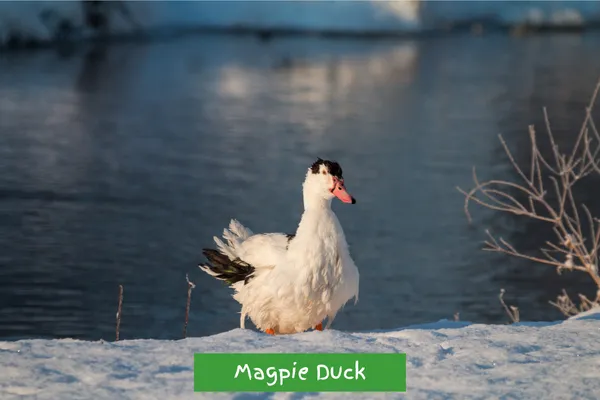
Magpies originated from England and Wales. They’re a good pest controller army. The black and white color of their body makes them more charming. Anyway, let’s get to know them more in a nutshell.
| Characteristic | Description |
|---|---|
| Appearance | Black and white outfit, 5 to 6 pounds in size |
| Nature | Friendly, likes human company |
| Suitable for beginners, | |
| Weight | 4 – 5 pounds |
| Adaptability | High adaptability |
| Hardy breed | |
| Lifespan | 8 – 12 years |
| Serving Purpose | Pest control for gardens |
| Good egg layers (255 eggs per year on average), colorful eggs (white, blue, or green) | |
| Suitable for Meat production | |
| Disease Resistance | Resistant to illnesses, low maintenance |
| Unique Feature | Standout black and white feathers |
To put it simply, they’re hardy, are good egg layers, rarely get sick and of course, look cool with their classic black-and-white appearance.
9. Buff Orpington
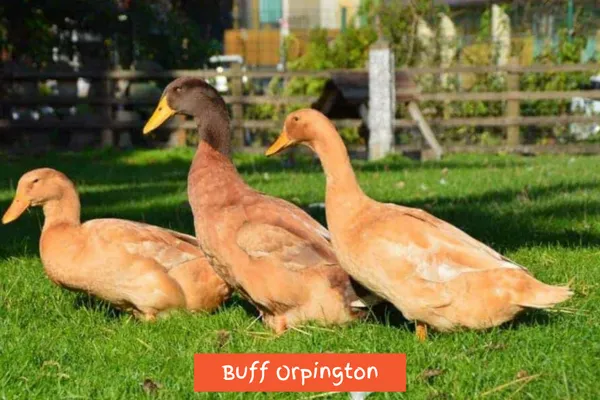
Buff Orpington ducks are hardy. But they’re popular mainly for their kind nature and cooperation with their owners. This English breed is too adorable.
| Feature | Description |
|---|---|
| Appearance | Male: Golden buff with a curly tail feather and a raspy voice. |
| Female: Golden buff with a typical loud QUACK and no curly tail feather. | |
| Weight | 5 – 8 pounds |
| Nature | Friendly and easygoing, not fussy |
| Adaptability | Thrive in various environments (city or country) |
| Lifespan | 5 – 10 years |
| Serving Purposes | Lay 150 to 220 eggs per year Decent egg size |
| Disease Resistance | Good disease resistance, less worry |
| Unique Feature | Don’t fly away, stay close to home |
Buff Orpingtons are hardy, with an average lifespan of around 6 to 10 years. They’re a perfect breed as pets. Because they look cool, are very well-behaved, do not fly away, and stay close to their living space.
There’s zero chance that you’re gonna lose them. What else do you want if you love petting as a hobby?
Related Articles:
10. Mallard Duck
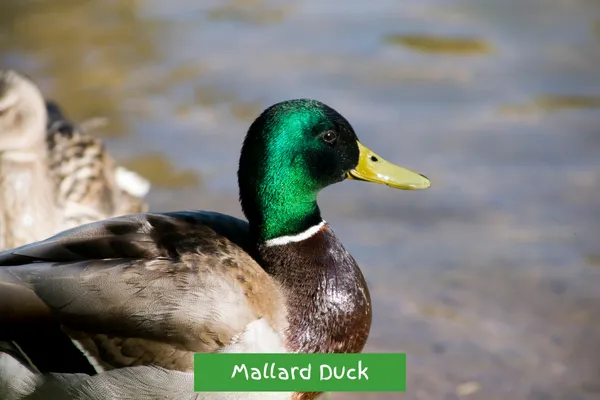
Mallard ducks are basically Asian natives. But they’re vastly found in North America and Europe as well. These backyard birds are brilliant foragers and less prone to illness.
| Feature | Description |
|---|---|
| Appearance | Male: dark green heads, yellow bills, and gray bodies |
| Female: mottled brown with orange and brown bills | |
| Nature | Friendly but might be a little shy |
| Weight | Up to 3.5 pounds |
| Adaptability | Highly adaptable, found in various habitats worldwide |
| No problems in a backyard setting | |
| Lifespan | 5 – 10 years |
| Serving Purposes | Suitable for ornamental purposes Average egg (around 150 eggs per year) |
| Disease Resistance | Fair disease resistance but requires care and monitoring |
| Unique Feature | Migratory behavior, often seen in large flocks in nature |
Mallard ducks can fly. In fact, they can be called migratory. Sounds crazy? Do not worry. I still kept this bird on the list because they do not usually fly if they find enough food and water. So, make sure they’re in a proper environment and can forage.
Recommended Reading: What Do Mallard Ducks Eat
Bottom Line
You can choose any duck breed as a pet, but some popular options for pet ducks include Pekin, Welsh Harlequin, Cayuga, Indian Runners, Khaki Campbells, Blue Swedish, and Buff Orpington. If properly cared for, even wild ducks like Mallards can make good pets.
Ultimately, it’s up to you to decide which breed suits you best. Just remember to meet their basic needs, like enough space and opportunities to forage, regardless of the breed you choose.
Source and Reference:
- https://www.ncbi.nlm.nih.gov/pmc/articles/PMC8261006/
- https://livestockconservancy.org/heritage-breeds/heritage-breeds-list/welsh-harlequin-duck/
- https://www.researchgate.net/publication/297342352_Egg_quality_traits_of_khaki_campbell_native_ducks_and_their_crossbreds

